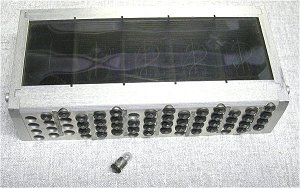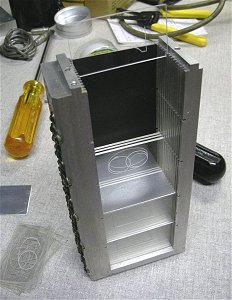|



































|
 |
 Non-Linear Systems
Non-Linear Systems
 |
Non-Linear Systems Model 481
Edge Lit Display Teardown
|
The 481's Edge Lit Display
(The First Type Of Digital Display)
The 481 digital voltmeter's display was four digits and consisted of five sections. Four sections contained eleven clear Lucite plates, each
engraved with a single digit from 0 to 9 or a decimal point.
The voltmeter was auto-ranging and the left most section of the
display contained clear plates with a "+" or "-" sign engraved in them to show polarity of the reading.
The plate containing the correct digit in each section of the 481 was lit by a small incandescent lamp pressed into the assembley
under the bottom of each plate. This first type of early digital display was known as an edge-lit display.
|

Click on any photo for larger image.
Watch Video (New window - YouTube)
|

Replacing Lamps
Lamp failure was common with constant use but the design of this unit allowed easy lamp replacement.
The display assembly was designed to be removed through the front panel without using any tools.
This allowed replacement of the lamps quickly on the bench or in the field.
|

Front Panel Access
Click on photo for larger image.
|
The display sits on top of a lamp contact board and is held in place by a tall spring clip on each side. To remove the display push each spring clip to the side and pull the display out on an angle.
To reinsert the display, hold it face down and line up the guide screw on each side in the clips. Then push the display back in and angle it back up. The spring clips will lock it in place.
|

Display Lamp Contacts and clips
Click on photo for larger image.
|
The display uses and individual GE 328 lamp for every number in each digit, 44 total.
The lamps are inserted in the bottom of the display and each has a small slot above it to illuminate one single engraved Lucite plate.
|

Display Lamps
Click on photo for larger image.
|
I also took apart the display assembly (BIG mistake) to show the engraved Lucite plates.
They are each held in place by machined slots in the assembly.
|

Lucite Display Digits
Click on photo for larger image.
|
Once I removed the top of the assembly I realized the plates would not line up again by themselves and I might have a problem putting it back together.
After staring at the thing for about five minutes wishing I hadn't taken it apart, I relized I could reassemble the top, bottom,
and one side then carefully slide each individual digit back into it's correct position.
|

Lucite Display Re-assembly
Click on photo for larger image.
|

Relays
These early NLS digital meters used a resistor dividing network and stepper relays to select the display digits.
If you see one of these in operation you will hear a lot of mechanical relay noise as the range and digits are selected. (Watch Video)
|

NLS 481 Relays
Click on photo for larger image.
|

My Non-Linear Systems Collection
|
|



